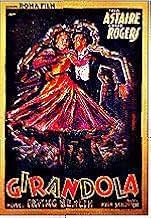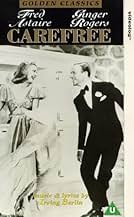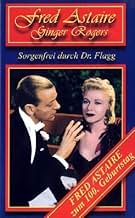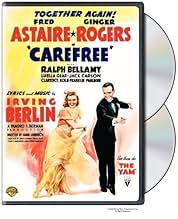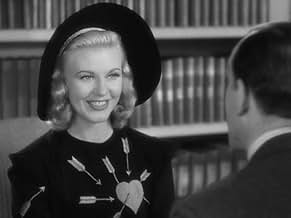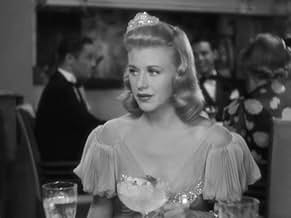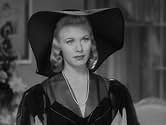NOTE IMDb
6,9/10
4,5 k
MA NOTE
Ajouter une intrigue dans votre langueA psychiatrist falls in love with the woman he's supposed to be nudging into marriage with someone else.A psychiatrist falls in love with the woman he's supposed to be nudging into marriage with someone else.A psychiatrist falls in love with the woman he's supposed to be nudging into marriage with someone else.
- Réalisation
- Scénario
- Casting principal
- Nommé pour 3 Oscars
- 3 victoires et 4 nominations au total
The Robert Mitchell Boy Choir
- Vocal Ensemble
- (scènes coupées)
- (as Robert B. Mitchell and his St. Brendan's Boys)
Harry A. Bailey
- Sponsor
- (non crédité)
Bobby Barber
- Minor Role
- (non crédité)
Cliff Bergere
- Minor Role
- (non crédité)
Ralph Brooks
- Country Club Guest
- (non crédité)
James P. Burtis
- Glass Truck Driver
- (non crédité)
Harry Campbell
- Minor Role
- (non crédité)
James Carlisle
- Country Club Guest
- (non crédité)
Charles Coleman
- Doorman
- (non crédité)
Avis à la une
If you attempt to look at the plot carefully (never a good idea in a musical) this is a rather repellent movie. The practice of Psychotherapy wasn't as well known or as well respected as it is today, and the film was clearly written by someone who seemed to think of it as some fad medical cure indulged in mainly by rich and foolish women. As such we get to see Fred Astaire, the therapist, subjecting Ginger Rogers, the patient, to all manner of barbaric (to modern eyes) treatments in order to find out why she won't marry his best friend. Eventually Astaire uses hypnosis to force her to marry him, and then force him not to. Clearly, movie doctors were not subjected to as severe a code of ethics as are real ones.
Its a pretty typical outing for Astaire and Rogers. Astaire's dancing is extraordinary (the dance scene on the golf course is great, as is the one where he dances with a hypnotized Rogers). Rogers' comic timing is, as always, wonderful. The secondary characters are all two-dimension cut-outs, but they're entertaining ones. If the characters didn't have quite the same sparkle to their interplay, remember, this was Astaire and Rogers' eighth film together and artistic differences were beginning to create a strain.
My biggest issue with this movie was the scene in which they sing the song "I Used To Be Colorblind". This was dream sequence, and it lasted about five minutes. "Carefree" is a black and white movie and the intent originally was to film the dream sequence in color a'la "Wizard of Oz". Apparently, somewhere in the production process, people balked at the cost and it was produced in black and white along with the rest of the film. Being filmed in black and white makes the song, and the entire sequence makes not one lick of sense, because the song is about how crisp and clear the world seems in color. Not only that, but since it was designed to be viewed on color film, not in black and white, the sets weren't designed with that same high degree of contrasts they would have if they had been designed to be viewed in black and white. As such, things in the dream sequence are LESS clear than in the rest of the movie, not more. I'm just appalled that the studio could spring for a few minutes of color footage for a film with such proved money-makes as Astaire and Rogers.
Its a pretty typical outing for Astaire and Rogers. Astaire's dancing is extraordinary (the dance scene on the golf course is great, as is the one where he dances with a hypnotized Rogers). Rogers' comic timing is, as always, wonderful. The secondary characters are all two-dimension cut-outs, but they're entertaining ones. If the characters didn't have quite the same sparkle to their interplay, remember, this was Astaire and Rogers' eighth film together and artistic differences were beginning to create a strain.
My biggest issue with this movie was the scene in which they sing the song "I Used To Be Colorblind". This was dream sequence, and it lasted about five minutes. "Carefree" is a black and white movie and the intent originally was to film the dream sequence in color a'la "Wizard of Oz". Apparently, somewhere in the production process, people balked at the cost and it was produced in black and white along with the rest of the film. Being filmed in black and white makes the song, and the entire sequence makes not one lick of sense, because the song is about how crisp and clear the world seems in color. Not only that, but since it was designed to be viewed on color film, not in black and white, the sets weren't designed with that same high degree of contrasts they would have if they had been designed to be viewed in black and white. As such, things in the dream sequence are LESS clear than in the rest of the movie, not more. I'm just appalled that the studio could spring for a few minutes of color footage for a film with such proved money-makes as Astaire and Rogers.
Hilarious and very stylish, this spellbinding art moderne musical is a real experiment in RKO craftsmanship. Did you know the dream sequences to the song "I used to be color blind" were originally filmed in color but the release abandoned because RKO couldn't get the tech specs right and the cost was going to be too high for the budget already set. It was a great idea and today might have made CAREFREE a more enduring success as there is no color footage of them as a dancing pair until 1949 at MGM.. Apart from the snazzy look of the art direction, Ginger's fantastic 'hearts and arrows' outfit and big black bewitching hat and the RKO world of the stone and timber country club, the music here is just terrific. The swing antics of the golf club bagpipe sequence had one audience I saw it with in rapturous applause. But I defy anyone to stay seated during THE YAM as they wing and swing their way all over the BIG SET Country club. CAREFREE is just great.
this is one of my favorite fred astaire/ginger rogers films. it's highly amusing how she toys with him at the beginning of the film, and then once he begins hypnosis, they have one of the best dance scenes i've ever seen between them. as always, their magic together is astounding.
In the eighth of ten screen appearances together, Fred Astaire and Ginger Rogers were firmly established as Hollywood's leading dancing pair. What is interesting about this 1938 entry is that it feels less like a musical and more like a screwball farce with musical interludes composed by Irving Berlin. The other less tangible aspect is that one can sense the two were growing in different directions at this particular juncture. While Astaire is still his debonair, nimble-footed self and as immaculate a dancer as ever there was on screen (watch his golfing solo for proof), Rogers seems to find surer footing as a crack comedy actress this time around. That's not to say they don't create magic when they dance. Indeed they do, an especially wonderful treat captured crisply on the newly released DVD, but you can somehow feel the beginning of the end.
Credited to no less than seven writers, the nonsensical plot focuses on singer Amanda Cooper, a radio star who has broken off her engagement three times to Stephen Arden, a rich bon vivant who spends an inordinate amount of time at the country club. Concerned about her flightiness but convinced that she is the one for him, he consults with his psychiatrist friend, Dr. Tony Flagg. Upon Stephen's insistence, Amanda goes to see Tony, and things immediately start off on the wrong foot when she overhears some of Tony's insensitive remarks about women on a dictaphone. Amanda and Tony eventually bury the hatchet over an accident-prone bike ride and become friends. You can probably figure out the rest of the complications that occur.
Even though Astaire acquits himself well as Tony (a rare role where he is not a professional entertainer) and Ralph Bellamy gamely plays yet another third-wheel role as Stephen, it is really Rogers who dominates the comedy scenes with her sharp timing and spirited manner. Moreover, the dance numbers don't disappoint with a lovely dream sequence set to "(I Used to Be) Colorblind" and a concluding romantic pas-de-deux cast under a hypnotic spell in "Change Partners". But my personal favorite is "The Yam", a jazzy, acrobatic number meant to replicate the late-thirties dance crazes. With Astaire bouncing Rogers on a series of cushiony chairs and then gracefully twirling her airborne over his table-affixed leg, this one may be my favorite of all their screen dances based on their sheer energy and athleticism.
For whatever reason, the supporting cast is not nearly as memorable as other Astaire-Rogers films at the time with Luella Gear looking a little too young as Amanda's Aunt Cora, Clarence Kolb as crabby Judge Travers and a young Jack Carson as Tony's helpful clinic assistant (doing a pretty decent Japanese accent over the phone). While the use of psychoanalysis must have been quite novel at the time, it feels rather clichéd now. Nonetheless, Astaire and Rogers still make magic regardless of the story contrivance. The 2006 DVD contains two vintage extras a twenty-minute, tap dancing short called "Public Jitterbug #1" about an outlaw jitterbug dancer, and a brief cartoon, "September in the Rain", where famous icons displayed on packaged foods of the day come to life.
Credited to no less than seven writers, the nonsensical plot focuses on singer Amanda Cooper, a radio star who has broken off her engagement three times to Stephen Arden, a rich bon vivant who spends an inordinate amount of time at the country club. Concerned about her flightiness but convinced that she is the one for him, he consults with his psychiatrist friend, Dr. Tony Flagg. Upon Stephen's insistence, Amanda goes to see Tony, and things immediately start off on the wrong foot when she overhears some of Tony's insensitive remarks about women on a dictaphone. Amanda and Tony eventually bury the hatchet over an accident-prone bike ride and become friends. You can probably figure out the rest of the complications that occur.
Even though Astaire acquits himself well as Tony (a rare role where he is not a professional entertainer) and Ralph Bellamy gamely plays yet another third-wheel role as Stephen, it is really Rogers who dominates the comedy scenes with her sharp timing and spirited manner. Moreover, the dance numbers don't disappoint with a lovely dream sequence set to "(I Used to Be) Colorblind" and a concluding romantic pas-de-deux cast under a hypnotic spell in "Change Partners". But my personal favorite is "The Yam", a jazzy, acrobatic number meant to replicate the late-thirties dance crazes. With Astaire bouncing Rogers on a series of cushiony chairs and then gracefully twirling her airborne over his table-affixed leg, this one may be my favorite of all their screen dances based on their sheer energy and athleticism.
For whatever reason, the supporting cast is not nearly as memorable as other Astaire-Rogers films at the time with Luella Gear looking a little too young as Amanda's Aunt Cora, Clarence Kolb as crabby Judge Travers and a young Jack Carson as Tony's helpful clinic assistant (doing a pretty decent Japanese accent over the phone). While the use of psychoanalysis must have been quite novel at the time, it feels rather clichéd now. Nonetheless, Astaire and Rogers still make magic regardless of the story contrivance. The 2006 DVD contains two vintage extras a twenty-minute, tap dancing short called "Public Jitterbug #1" about an outlaw jitterbug dancer, and a brief cartoon, "September in the Rain", where famous icons displayed on packaged foods of the day come to life.
The upper-class Stephen Arden (Ralph Bellamy) brings his fiancée, the radio singer Amanda Cooper (Ginger Rogers), to be consulted by his friend, the psychoanalyst Dr. Tony Flagg (Fred Astaire), to improve their relationship. Amanda listens to the record made by Dr. Flagg about her and has an initial friction with the shrink. But sooner she falls in love with him and discloses her feelings to Dr. Flagg. He decides to hypnotize Amanda to loath him and love Stephen. However his subconscious makes him perceive that he also loves Amanda. But Stephen obtains a restrain order against his friend and he can not get close to Amanda to withdrawal his former hypnotic suggestion.
"Carefree" is a delightfully naive and adorable classic, with a silly story but wonderful dance numbers of the constant pair Fred Astaire and Ginger Rogers. Ginger "steals" the film not only dancing, but also with a funny performance. My vote is seven.
Title (Brazil): "Dance Comigo" ("Dance with Me")
"Carefree" is a delightfully naive and adorable classic, with a silly story but wonderful dance numbers of the constant pair Fred Astaire and Ginger Rogers. Ginger "steals" the film not only dancing, but also with a funny performance. My vote is seven.
Title (Brazil): "Dance Comigo" ("Dance with Me")
Le saviez-vous
- AnecdotesThis was the first Fred Astaire-Ginger Rogers film to lose money on its initial release. It lost $68,000 (~ $1.48M in 2024) for RKO according to studio records.
- GaffesAs Amanda (Ginger Rogers) exits the taxicab and starts to cross the street for the theatre, you can see the reflection of the roof line behind her in the large piece of plate glass on the truck. On the roof line, you can see the rigging pipes for lights and other equipment showing it's a back lot set.
- Citations
Stephen Arden: [drunkenly] Oh, uh, could you give me a little information?
Doorman: Yes sir.
Stephen Arden: Thank you.
[walks away]
- Crédits fousDuring opening credits, a pair of hands finger-paints names, pauses, wipes them out, and writes the next set of names several times.
- ConnexionsFeatured in Fred Astaire: Puttin' on His Top Hat (1980)
- Bandes originalesSince They Turned Loch Lomond into Swing
(1938) (uncredited)
Music by Irving Berlin
Danced by Fred Astaire
Meilleurs choix
Connectez-vous pour évaluer et suivre la liste de favoris afin de recevoir des recommandations personnalisées
- How long is Carefree?Alimenté par Alexa
Détails
Box-office
- Budget
- 1 253 000 $US (estimé)
- Durée1 heure 23 minutes
- Couleur
- Rapport de forme
- 1.37 : 1
Contribuer à cette page
Suggérer une modification ou ajouter du contenu manquant


